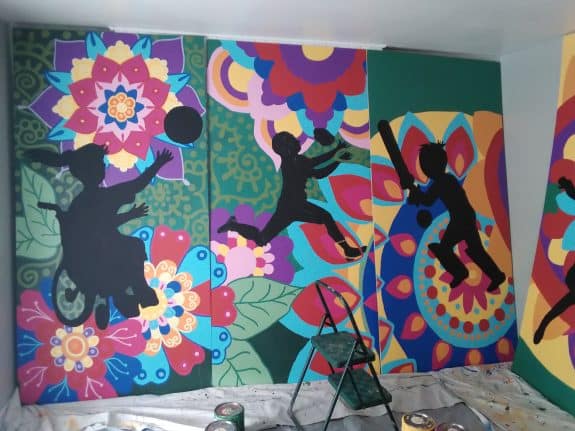MORE THAN A MURAL
By Maya White
Visiting the most densely populated neighborhood in Houston, within which about 80 languages spanning from 40 countries co-exist, leaves you feeling one thing — inspired. There are worlds within the Gulfton community, and it’s weathered many a test to survive, and now, there seems to be more hope than ever before. Between local neighborhood entities such as the Southwest Multi-Service Center, Legacy Health, The Alliance, and Baker Ripley, to organizations like Culture of Health – Advancing Together (C.H.A.T) and Connect Community (among many, many more) — Gulfton seems to be on its way to an infrastructurally sound and artist-centered future. But can this artistic future expand beyond the many murals that are being produced in and for the Gulfton community?
This art-filled future was jump started by the Mayor’s Office of Cultural Affairs Complete Communities initiative, and organizations like C.H.A.T quickly followed suit when the Gulfton Story Trail was launched. This project includes 12 murals in the Gulfton area and completes one main benefit of public art, cultural awareness.
DiverseWorks’ Project Freeway Fieldwork team was able to meet up with two large names in the Houston mural scene who have been a part of Gulfton’s transforming story in relation to the arts. The first was Anat Ronen, whose story is as magnificent and inspiring as the Gulfton area. An immigrant and self-taught artist, Anat received the O-1 nonimmigrant visa and created murals as a means to survive. With little to no support, Anat has built a name for herself by creating astonishing, and oftentimes space-bending, murals. Anat, who participated in the Story Trail and has graciously donated a mural to SHAPE Center, has been very involved in bringing the spirit and stories of our communities to life. She warns though that not every artist can be a muralist, it takes time and can be difficult to work on such a large scale — which begs the question, how else can we support neighborhoods through public art other than mural projects, which seem to be the primary public art go-to?
Our meeting with Amy Malkan, who has a vast portfolio of mural work in the city as well, shed light on the power a mural can have on a community when it’s built by and for the community. Amy recently worked with youth of C.H.A.T to create a mural to be displayed in their apartment complex— a mural that not only speaks to their life story, but features them. “ They were so excited to work on this project” Amy explains, “… and that it deals with their reality. For example this panel has a boy playing cricket. You don’t hear about cricket here in the States, but in their hometowns, it’s a huge part of everyday life!”

We witnessed the power of murals, but our conversation with artist Eepi Chad, who is also the director of Community Engagement at Art League Houston, brings us back to the question — what more can be produced under the sphere of public art? Eepi, who grew up in the Gulfton / Sharpstown area during the fundamental years of her life, worked with residents to create a fiber installation on the Baker Ripley Gulfton campus that houses their stories. As a part of this project, she first engaged in important dialogue with Gulfton residents of all ages about their desires for themselves, their community, and their history. Eepi advises, “…we need public art that pushes beyond murals…it could be temporary projection work that is used to highlight physical spaces, or utilizing esplanade because Gulfton is a pedestrian community — people ride bikes and use public transit.”
A neighbor of Gulfton and an art teacher for 20 years at Neff Elementary in Sharpstown , artist Gerardo Rosales agrees with Eepi’s statement. When we spoke to him about his experiences within the area, and his opinion about the existence of public art, he mentioned he’s had a hand in the murals created on the Neff campus, but how a large sculpture in the area would be of great benefit.
Neighborhoods shift, and there seems to be a positive one occurring in the Gulfton area where the voices of residents are being sought out and heard. With 80 different languages, one is beginning to resound — the language of art. Here’s to hoping Gulfton / Sharpstown artists continue to emerge and see how their unique practices will add to the transformation happening in their neighborhood.
Photo by Perata Bradley
